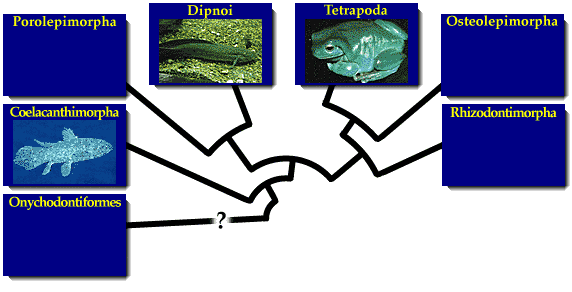
The Sarcopterygii are the lobe-finned fish and the tetrapods. The name Sarcopterygii (or sometimes Crossopterygii) used to refer only to the fish members of the group, but since it has become clear that the Tetrapoda evolved from sarcopterygian fish, the definition of the group has been expanded. The precise relationships among all the Sarcopterygii are still a matter of debate, and there are many competing hypotheses. The cladogram below represents one such hypothesis.

The earliest lobe-finned fish are found as fossils in the Lower Devonian, and by the end of this period all major lineages had appeared. These early lobe-fins were fast-swimmers with a heterocercal tail, meaning that the tail fin was asymmetrical and larger on the dorsal side. In the living lobe-finned fish (lungfish and coelacanths) the tail is now symmetric, though the fossil record shows that this change happened independently in the two groups.
One of the most important characteristics of lobe-finned fish is the lobe in their fins. Unlike other fish, sarcopterygian fish has a cental appendage in their fins containing many bones and muscles. The fins are very flexible and potentially useful for supporting the body on land, as in lungfish and tetrapods. Additionally, the Sarcopterygii is known for having enamel on the teeth.
We have an exhibit on the Blue Nile Gorge in Ethiopia, which includes images of fossil lungfish.
Visit the Tree of Life for references and current information on Sarcopterygii phylogeny.


